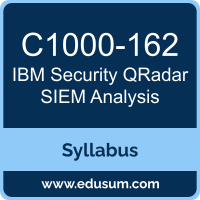 Use this quick start guide to collect all the information about IBM Security QRadar SIEM Analysis (C1000-162) Certification exam. This study guide provides a list of objectives and resources that will help you prepare for items on the C1000-162 IBM Security QRadar SIEM V7.5 Analysis exam. The Sample Questions will help you identify the type and difficulty level of the questions and the Practice Exams will make you familiar with the format and environment of an exam. You should refer this guide carefully before attempting your actual IBM Security QRadar SIEM Analysis certification exam.
Use this quick start guide to collect all the information about IBM Security QRadar SIEM Analysis (C1000-162) Certification exam. This study guide provides a list of objectives and resources that will help you prepare for items on the C1000-162 IBM Security QRadar SIEM V7.5 Analysis exam. The Sample Questions will help you identify the type and difficulty level of the questions and the Practice Exams will make you familiar with the format and environment of an exam. You should refer this guide carefully before attempting your actual IBM Security QRadar SIEM Analysis certification exam.
The IBM Security QRadar SIEM Analysis certification is mainly targeted to those candidates who want to build their career in IBM Security domain. The IBM Certified Analyst - Security QRadar SIEM V7.5 exam verifies that the candidate possesses the fundamental knowledge and proven skills in the area of IBM Security QRadar SIEM Analysis.
IBM Security QRadar SIEM Analysis Exam Summary:
| Exam Name | IBM Certified Analyst - Security QRadar SIEM V7.5 |
| Exam Code | C1000-162 |
| Exam Price | $200 (USD) |
| Duration | 90 mins |
| Number of Questions | 64 |
| Passing Score | 64% |
| Books / Training |
IBM Certified Analyst: Security QRadar SIEM V7.5 - Exam C1000-162 Preparation Guide QRadar SIEM Analyst learning plan |
| Schedule Exam | Pearson VUE |
| Sample Questions | IBM Security QRadar SIEM Analysis Sample Questions |
| Practice Exam | IBM C1000-162 Certification Practice Exam |
IBM C1000-162 Exam Syllabus Topics:
| Topic | Details | Weights |
|---|---|---|
| Offense Analysis |
- QRadar uses rules to monitor the events and flows in your network to detect security threats. When the events and flows meet the test criteria that is defined in the rules, an offense is created to show that a security attack or policy breach is suspected. But knowing that an offense occurred is only the first step. Offense Analysis is all about initially identifying how it happened, where it happened, and who are the players involved in the offense.
|
23% |
| Rules and Building Block Design |
- QRadar rules are applied to all incoming events, flows, or offenses to search for or detect anomalies. If all the conditions of a test are met, the rule generates a response. A building block is a collection of tests that don't result in a response or an action. A building block groups commonly used tests to build complex logic so that it can be reused in rules. As an Analyst you need to fully understand how rules and building blocks are designed and used, and although you are not responsible for implementing new or tuning existing rules and building blocks, you can and should make recommendations on updating QRadar components that may improve rules and building block design based on your daily exposure to them.
|
18% |
| Threat Hunting |
- After the initial Offense Analysis and based on technical skills in understanding QRadar rules and building block design, it is time to focus on the Analyst's main task of Threat Hunting. Starting with the results presented in an offense, the Analyst will investigate the evidence inside an offense, such as event and flow details, triggered rules, payloads, and more. Utilizing filters and advanced searches the Analyst will be able to distinguish real threats from false positives.
|
24% |
| Dashboard Management |
- Use the QRadar Dashboard tab to focus on specific areas of your network security. The workspace supports multiple dashboards on which you can display your views of network security, activity, or data that is collected. You can use the QRadar Pulse app for an enhanced dashboard experience.
|
14% |
| Searching and Reporting |
- Effectively utilizing QRadar's search capability represents one of the foundational skills for an Analyst. These capabilities include filtering event, flow, and asset related data as well as creating quick and advanced searches, including the Ariel Query Language. Filters and searches can be used in various parts of the QRadar UI. - The Analyst can create, edit, distribute, and manage reports, including flexible options to satisfy your organization's various regulatory standards, such as PCI compliance, and offense and threat related reports.
|
21% |
To ensure success in IBM Security QRadar SIEM Analysis certification exam, we recommend authorized training course, practice test and hands-on experience to prepare for IBM Security QRadar SIEM V7.5 Analysis (C1000-162) exam.
